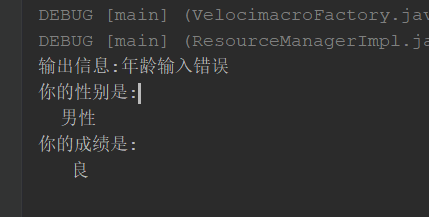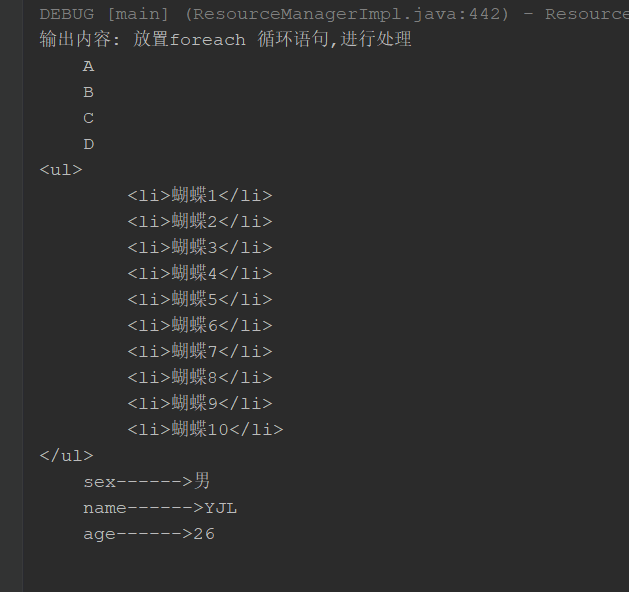二.二.二.二 If 条件语句 开发
@Test public void ifFillTest()throws Exception{ //1. 创建模板引擎 VelocityEngine velocityEngine=new VelocityEngine(); //2. 设置属性 velocityEngine.setProperty( RuntimeConstants.RESOURCE_LOADER,"classpath" ); velocityEngine.setProperty( "classpath.resource.loader.class", ClasspathResourceLoader.class.getName() ); //3. 进行初始化 velocityEngine.init(); //4.获取对应的模板信息 Template template=velocityEngine.getTemplate("if.vm"); //5. 构建 VelocityContext 对象,里面放置内容 Map<String,Object> root=new HashMap<>(); root.put("age",130); root.put("sex","男"); root.put("score",86); VelocityContext velocityContext=new VelocityContext(root); //6. 找到StringWriter对象,进行合并 StringWriter stringWriter=new StringWriter(); template.merge(velocityContext,stringWriter); System.out.println("输出信息:"+stringWriter.toString()); }
二.二.三 foreach 循环语句 展示
二.二.三.一 foreach 循环语句 vm
创建 foreach.vm 文件
#[[ 放置foreach 循环语句,进行处理 ]]# ## 放置 list或者数组 array #foreach ($hobby in $hobbys) $hobby #end #if(${users}) <ul> #foreach($user in $users) <li>${user.name}</li> #end </ul> #end ## 放置map语句 #foreach($key in $infoMap.keySet()) ${key}------>${infoMap.get(${key})} #end
二.二.三.二 foreach 循环语句 开发
User.java
@Data public class User { private Integer id; private String name; private Integer sex; private Integer age; private String description; }
@Test public void foreachTest() throws Exception{ //1.创建 VelocityEngine 引擎 VelocityEngine velocityEngine=new VelocityEngine(); //2. 设置属性 velocityEngine.setProperty( RuntimeConstants.RESOURCE_LOADER,"classpath" ); velocityEngine.setProperty( "classpath.resource.loader.class", ClasspathResourceLoader.class.getName() ); //3. 进行初始化 velocityEngine.init(); //4.获取模板 Template template=velocityEngine.getTemplate("foreach.vm"); //5.进行填充数据 Map<String,Object> root=new HashMap<>(); String[] hobbys=new String[4]; hobbys[0]="A"; hobbys[1]="B"; hobbys[2]="C"; hobbys[3]="D"; root.put("hobbys",hobbys); List<User> userList=getUserList(); root.put("users",userList); Map<String,Object> infoMap=new HashMap<>(); infoMap.put("name","YJL"); infoMap.put("age",26); infoMap.put("sex","男"); root.put("infoMap",infoMap); //6. 创建 VelocityContext 对象,填充数据。 VelocityContext velocityContext=new VelocityContext(root); //7. StringWriter stringWriter=new StringWriter(); //8. 通过 merge 方法,进行填充数据。 template.merge(velocityContext,stringWriter); System.out.println("输出内容:"+stringWriter.toString()); } private List<User> getUserList() { List<User> userList=new ArrayList<>(); for(int i=1;i<=10;i++){ User user=new User(); user.setId(i); user.setName("蝴蝶"+i); user.setAge(i*3+1); user.setSex(i%2); user.setDescription("一个简单的描述"); userList.add(user); } return userList; }
二.二.四 macro宏语句 展示
二.二.四.一 macro宏语句 vm
创建 macro.vm 文件
## 这是宏,可以理解成一个函数。 ## 声明宏 sayHello 是方法名, $name 为参数 #macro(sayHello $name) 我们要讲述: $name #end ## 使用宏 #sayHello("周小欢和岳泽霖的故事") ## 定义加法 #macro(add $num1,$num2) #set($total=$num1+$num2) ## 直接使用相加的操作,还是字符串。 $num1+$num2=${total} #end #add(2,3)
二.二.四.二 macro宏语句 开发
@Test public void macroTests() throws Exception{ //1. 初始化模板引擎 VelocityEngine ve=new VelocityEngine(); //2. 设置相应的属性信息 ve.setProperty(RuntimeConstants.RESOURCE_LOADER,"classpath"); ve.setProperty("classpath.resource.loader.class", ClasspathResourceLoader .class.getName()); //3. 进行初始化 ve.init(); //4.获取模板文件 Template template=ve.getTemplate("macro.vm","utf-8"); //5.设置变量 VelocityContext velocityContext=new VelocityContext(); velocityContext.put("name","岳泽霖"); //6.进行合并,调用模板的 merge 方法, 将其进行填充。 StringWriter stringWriter=new StringWriter(); template.merge(velocityContext, stringWriter); System.out.println("输出信息值:" +stringWriter.toString()); }





